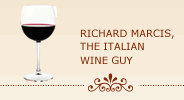Fine Italian Wines to Keep You Going During the Summer
Wine for august - Under $25
Nino Franco, “Rustico” Prosecco NV (about $17)
Prosecco is easily Italy’s most popular sparking wine. Light, refreshingly effervescent (“frizzante”) and inexpensive, it is an integral part of most luncheons, weddings, birthday parties and other festive occasions throughout Italy. It is also a popular before-dinner drink (aperitivo), particulary in the Veneto region of northern Italy where Prosecco is produced. While delicious on its own, Prosecco can also be combined with white peach nectar to make a Bellini, Venice’s most famous cocktail, or mixed with lemon sorbet to create a frothy, sweet after-dinner drink called a Sgroppino.
Prosecco is the name of the wine derived from the Prosecco grape, now known officially as the Glera grape. The white Prosecco, er Glera, grape thrives in the steeply-sloped hills between the towns of Conegliano (co neyl yah’ no) and Valdobbiadene (val doh bee ah’ deh nay) that define the Prosecco di Conegliano-Valdobbiadene DOCG. To qualify as Prosecco di Conegliano-Valdobbiadene DOCG, the wine's grapes have to be sourced exclusively in this zone.
Lying as it does in the foothills of the Alps, the Prosecco di Conegliano-Valdobbiadene DOCG is blessed with an invigoratingly cool climate interspersed with warm summer days and abundant rainfall, an ideal environment for growing Glera. While some Prosecco is made entirely with Glera grapes, the regulations permit the addition of varying amounts of other white grape varieties.
Founded in Valdobbiadene in 1919, the Nino Franco winery is one of the oldest and most highly-regarded Prosecco producers. Nino Franco’s “Rustico” is a refreshing, lightly sparkling white wine produced from 100 percent Glera grapes grown in the hills around Valdobbiadene. It has a delicate bouquet and a taste imprinted with peach and citrus fruit notes and a pleasant, slightly bitter note on the finish. This may well be one of the best expressions of Prosecco under $20.
As with other Prosecco wines, the “Rustico” is a superb aperitivo and pairs well mith most hors d’oeuvres and snacks. But it also is a perfect match with hard-shell seafood such as lobster, crab, shrimp and mussels. It also goes well with light, first-course dishes such as simple pasta dishes, soups and salads.
Nino Franco’s NV “Rustico” Prosecco is inexpensive so you can buy it by the case for those festive occasions that call for something fizzy and fun.
Wine for august – $25 and over
Castello Banfi, “Summus” 2006 (about $65)
Summus. Just the name connotes power, strength and robustness and this wine doesn’t disappoint in this regard. A tripartite blend of Sangiovese, Cabernet Sauvignon and Syrah, this Super-Tuscan is rich, structured and full-bodied and yet remarkably balanced.
Banfi, more formally known as Castello Banfi, is a prominent estate and winery located near the picturesque hill-top town of Montalcino in the heart of Tuscany’s prestigious Brunello zone. Started from scratch in the late 1970’s by brothers John and Harry Mariani from the New York City area, it today owns a big chunk of Tuscan real estate. With over 2,400 acres of prime land under vine, it is a large estate by any measure but especially by Tuscan standards where small to medium-size family vineyards and wineries are the norm. Additionally, while most Tuscan estates typically focus their efforts on a limited number of wines, the Banfi estate produces and markets a wide range, literally dozens, of red, white and dessert wines at all price points.
Summus is one of several high-end Sangiovese-based wines produced by Castello Banfi. It consists of 25 percent Sangiovese, 40 percent Cabernet Sauvignon and 35 percent Syrah. The three varieties are fermented separately and then transferred to small oak barrels (barriques) where they age for approximately for 12 months. Afterwards, they are blended and then sent back to further age in wooden casks for an additional 10 to 12 months. The wine is then bottled and spends an additional 6 months in the bottle prior to release for sale.
by Castello Banfi. It consists of 25 percent Sangiovese, 40 percent Cabernet Sauvignon and 35 percent Syrah. The three varieties are fermented separately and then transferred to small oak barrels (barriques) where they age for approximately for 12 months. Afterwards, they are blended and then sent back to further age in wooden casks for an additional 10 to 12 months. The wine is then bottled and spends an additional 6 months in the bottle prior to release for sale.
There is a lot of time and work involved in making Summus but the results are worth the effort. It has a dense ruby/purple color with a rich and ample bouquet of black fruit and kitchen spices that nearly leap out of the glass after a little swirling. It has a weightly structure with an almost chewy texture and mouthfeel but it doesn’t sacrifice its sense of style and subtlety. Summus’s pronounced dark fruit flavors are encompassed by a symphony of spicy oak flavors. A long, concentrated finish is just icing on the cake.
The 2006 vintage was an excellent year, one of the best, for Sangiovese in Tuscany. The ’06 Summus is ready to drink now but will only improve with additional time. This is one to make room for in your wine cellar.
This wine goes well with hearty dishes such as roasted or grilled red meats, game, stews and aged cheeses.
Note – prices indicated are averages of generally available retail prices and will vary from store to store. While in stock at time of writing, stores may sell out of the selections so availability is not guaranteed. It is best to call to check on price and availability before making the trip.
©Richard Marcis
August 9, 2011
To read reviews of other super-Tuscan wines, see top super-tuscan wines
To return to wines of the month selections see Monthly Wine Reviews



